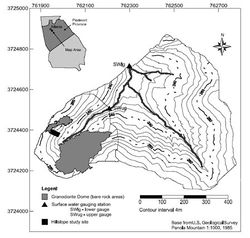Difference between revisions of "Panola Mountain Research Watershed"
m (→Location) |
m |
||
| Line 5: | Line 5: | ||
== Catchment size == | == Catchment size == | ||
* 41 ha main catchment | * 41 ha main catchment | ||
| − | * 10 ha sub-catchment located in the western part of the catchment | + | * 10 ha sub-catchment located in the western part of the main catchment |
* 0.1 ha trenched hillslope | * 0.1 ha trenched hillslope | ||
| Line 11: | Line 11: | ||
Humid continental to subtropical. | Humid continental to subtropical. | ||
| − | The mean annual precipitation is ~1240 mm, which on average is distributed uniformly throughout the year. Rainfall typically has a long duration and low intensity associated with the passage of fronts in the winter and | + | The mean annual precipitation is ~1240 mm, which on average is distributed uniformly throughout the year. Rainfall typically has a long duration and low intensity associated with the passage of fronts in the winter and a short duration and high intensity associated with convective rainstorms in the summer. Less than 1% of the precipitation falls as snow or sleet. A long growing season, warm temperatures, and many sunny days result in a high evapotranspiration demand, particularly during the summer. Air temperature averages 15.2°C and the average monthly temperatures range from 5.5°C in January to 25.2°C in July. |
== Geology == | == Geology == | ||
| − | The bedrock is predominantly the Panola Granite (granodiorite composition), a biotite–oligioclase– quartz–microcline granite of Mississippian to Pennsylvanian age. The Panola granite contains pods of amphibolitic gneiss, particularly at lower | + | The bedrock is predominantly the Panola Granite (granodiorite composition), a biotite–oligioclase– quartz–microcline granite of Mississippian to Pennsylvanian age. The Panola granite contains pods of amphibolitic gneiss, particularly at lower elevations. |
| − | Soils are predominantly ultisols developed in colluvium and residuum, which intergrades to inceptisols developed in colluvium, recent alluvium, or in highly eroded landscape positions. Typical soil profiles on the hillslopes are | + | Soils are predominantly ultisols developed in colluvium and residuum, which intergrades to inceptisols developed in colluvium, recent alluvium, or in highly eroded landscape positions. Typical soil profiles on the hillslopes are typically <1.6 m thick, grading into saprolite of variable thickness. The riparian zone has the deepest soils (>5 m). |
== Topography == | == Topography == | ||
| Line 31: | Line 31: | ||
* Precipitation | * Precipitation | ||
* Climate | * Climate | ||
| − | * Streamflow | + | * Streamflow |
* Several transects with recording wells | * Several transects with recording wells | ||
* Water quality (weekly and event sampling) | * Water quality (weekly and event sampling) | ||
Revision as of 05:06, 1 May 2007
Location
The Panola Mountain Research Watershed (PMRW) is located within the Panola Mountain State Conservation Park, about 25 km southeast of Atlanta, Georgia, USA (84°10’W, 33°37’N).
Catchment size
- 41 ha main catchment
- 10 ha sub-catchment located in the western part of the main catchment
- 0.1 ha trenched hillslope
Climate
Humid continental to subtropical.
The mean annual precipitation is ~1240 mm, which on average is distributed uniformly throughout the year. Rainfall typically has a long duration and low intensity associated with the passage of fronts in the winter and a short duration and high intensity associated with convective rainstorms in the summer. Less than 1% of the precipitation falls as snow or sleet. A long growing season, warm temperatures, and many sunny days result in a high evapotranspiration demand, particularly during the summer. Air temperature averages 15.2°C and the average monthly temperatures range from 5.5°C in January to 25.2°C in July.
Geology
The bedrock is predominantly the Panola Granite (granodiorite composition), a biotite–oligioclase– quartz–microcline granite of Mississippian to Pennsylvanian age. The Panola granite contains pods of amphibolitic gneiss, particularly at lower elevations.
Soils are predominantly ultisols developed in colluvium and residuum, which intergrades to inceptisols developed in colluvium, recent alluvium, or in highly eroded landscape positions. Typical soil profiles on the hillslopes are typically <1.6 m thick, grading into saprolite of variable thickness. The riparian zone has the deepest soils (>5 m).
Topography
The basin relief is 56 m and slopes average 18%.
Vegetation/Land use
The watershed contains a naturally regenerated second-growth forest on abandoned agricultural land, typical of the Piedmont physiographic province. The watershed is 90% forested, dominated by hickory, oak, tulip poplar, and loblolly pine, and 10% partially vegetated (lichens and mosses) bedrock outcrops. The forested area varies from 100% deciduous to 100% coniferous.
Context of investigation
The PMRW was established in 1985 as part of the USGS Acid Rain Thrust Program. In 1991, the 41-ha forested watershed became one of five Water, Energy and Biogeochemical Budgets (WEBB) sites focusing research on the movement of water and solutes within a small forested watershed and the effects of anthropogenic and environmental change. The experimental hillslope study site was established in 1995 with the excavation of a 20-m-long trench.
Measurements/Equipment
41 ha main catchment and 10 ha subcatchment:
- Precipitation
- Climate
- Streamflow
- Several transects with recording wells
- Water quality (weekly and event sampling)
- Soil moisture
0.1 ha hillslope study site:
- Lateral subsurface flow (trench)
- Soil moisture
- Groundwater
- Sapflow (Summer of 2002)
- Sprinkling experiments (Summer of 2002 and Fall of 2006)
- Tracer experiments (Summer of 2002 and Fall of 2006)
Links to project webpages
http://ga.water.usgs.gov/projects/panola/
